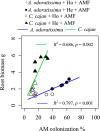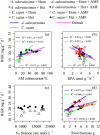Accumulation in nutrient acquisition strategies of arbuscular mycorrhizal fungi and plant roots in poor and heterogeneous soils of karst shrub ecosystems
- PMID: 35410135
- PMCID: PMC8996662
- DOI: 10.1186/s12870-022-03514-y
Accumulation in nutrient acquisition strategies of arbuscular mycorrhizal fungi and plant roots in poor and heterogeneous soils of karst shrub ecosystems
Abstract
Background: Arbuscular mycorrhizal (AM) fungi and roots play important roles in plant nutrient acquisition, especially in nutrient poor and heterogeneous soils. However, whether an accumulation strategy of AM fungi and root exists in such soils of karst shrubland ecosystems remains unclear. Root traits related to nutrient acquisition (root biomass, AM colonisation, root acid phosphatase activity and N2 fixation) were measured in two N2-fixing plants (i.e. Albizia odoratissima (Linn. f.) Benth. and Cajanus cajan (Linn.) Millsp.) that were grown in heterogeneous or homogeneous nutrient (ammonium) soil with and without AM fungi inoculation.
Results: Both of these plants had higher AM colonisation, root biomass and relative growth rate (RGR), but lower N2 fixation and root acid phosphatase activity in the rhizosphere in the heterogeneous soil environment, than that in the homogeneous soil environment. Plants grown in the AM fungi-inoculated heterogeneous soil environment had increased root biomass and root acid phosphatase activity compared with those grown in soil without inoculation. AM colonisation was negatively correlated with the N2 fixation rate of A. odoratissima, while it was not significantly correlated with the root phosphatase activity.
Conclusions: Our results indicated that enhanced AM symbiosis and root biomass increased the absorptive surfaces for nutrient acquisition, highlighting the accumulation strategies of AM and root traits for plant nutrient acquisition in nutrient poor and heterogeneous soils of the karst shrubland ecosystem.
Keywords: Arbuscular mycorrhizal (AM) fungi; Karst; Nutrient acquisition strategies; Root trait; Shrubland ecosystem; Soil nutrient heterogeneity.
© 2022. The Author(s).
Conflict of interest statement
The authors declare that they have no competing interests.
Figures






Similar articles
-
Root and mycorrhizal nutrient acquisition strategies in the succession of subtropical forests under N and P limitation.BMC Plant Biol. 2025 Jan 2;25(1):8. doi: 10.1186/s12870-024-06016-1. BMC Plant Biol. 2025. PMID: 39748305 Free PMC article.
-
An invasive plant experiences greater benefits of root morphology from enhancing nutrient competition associated with arbuscular mycorrhizae in karst soil than a native plant.PLoS One. 2020 Jun 9;15(6):e0234410. doi: 10.1371/journal.pone.0234410. eCollection 2020. PLoS One. 2020. PMID: 32516341 Free PMC article.
-
Arbuscular mycorrhizal fungal communities with contrasting life-history traits influence host nutrient acquisition.Mycorrhiza. 2023 Mar;33(1-2):1-14. doi: 10.1007/s00572-022-01098-x. Epub 2023 Jan 3. Mycorrhiza. 2023. PMID: 36595061
-
The Roles of Phosphorus and Nitrogen Nutrient Transporters in the Arbuscular Mycorrhizal Symbiosis.Int J Mol Sci. 2022 Sep 20;23(19):11027. doi: 10.3390/ijms231911027. Int J Mol Sci. 2022. PMID: 36232323 Free PMC article. Review.
-
[Advances in mechanisms of nutrient exchange between mycorrhizal fungi and host plants].Ying Yong Sheng Tai Xue Bao. 2019 Oct;30(10):3596-3604. doi: 10.13287/j.1001-9332.201910.034. Ying Yong Sheng Tai Xue Bao. 2019. PMID: 31621248 Review. Chinese.
Cited by
-
Effects of AMF on plant nutrition and growth depend on substrate gravel content and patchiness in the karst species Bidens pilosa L.Front Plant Sci. 2022 Sep 29;13:968719. doi: 10.3389/fpls.2022.968719. eCollection 2022. Front Plant Sci. 2022. PMID: 36247600 Free PMC article.
-
Potential Roles of Soil Microorganisms in Regulating the Effect of Soil Nutrient Heterogeneity on Plant Performance.Microorganisms. 2022 Dec 3;10(12):2399. doi: 10.3390/microorganisms10122399. Microorganisms. 2022. PMID: 36557652 Free PMC article. Review.
References
-
- Gross KL, Pregitzer KS, Burton AJ. Spatial variation in nitrogen availability in three successional plant communities. J Ecol. 1995;83:357–367. doi: 10.2307/2261590. - DOI
-
- Mommer L, Visser EJM, van Ruijven J. contrasting root behavior in two grass species: A test of functionality in dynamic heterogeneous conditions. Plant Soil. 2011;344:347–360. doi: 10.1007/s11104-011-0752-8. - DOI
-
- Smith SE, Read DJ. Mycorrhizal symbiosis. 3. London: Academic Press; 2008.
MeSH terms
Substances
Grants and funding
- KDL201803/the Foundation of Karst Dynamics Laboratory, MNR and GZAR
- 41907208/National Natural Science Foundation of China
- 31800441/the National Natural Science Foundation of China
- 31870503/the National Natural Science Foundation of China
- 2018GXNSFBA138012/the Natural Science Foundation of Guangxi
- AA20302018-9/the Guangxi Innovation Driven Development Special Fund Project of China
- U20A2011/Innovative Research Group Project of the National Natural Science Foundation of China
- KDL/the Opening Project of Guangxi Key Laboratory of Karst Dynamics
- Guangxi202102/the Opening Project of Guangxi Key Laboratory of Karst Dynamics
LinkOut - more resources
Full Text Sources

